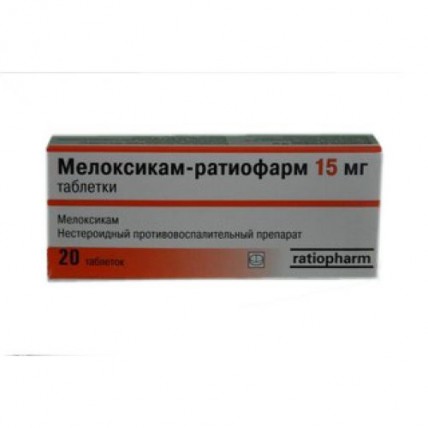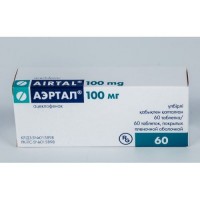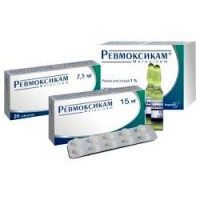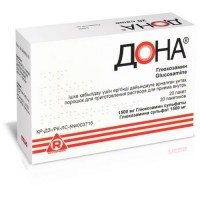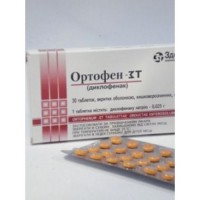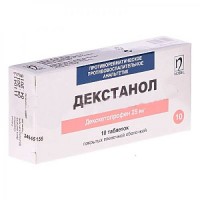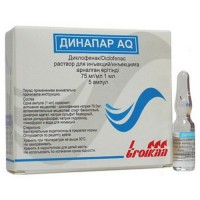Meloxicam-ratiopharm 15 mg (20 tablets)
- $15.90
The instruction for medical use
of medicine
Meloksikam-ratiopharm
the Trade name
Meloksikam-ratiopharm
the International unlicensed
name Meloksikam Lekarstvennaya a form
of the Tablet, 7.5 mg and 15 mg
Structure
One tablet contains
active agent - to meloksika of 7.5 and 15 mg
excipients: starch corn, starch prezhelatinizirovanny (starch 1500), silicon anhydride colloidal, sodium citrate, lactoses monohydrate, cellulose microcrystalline, magnesium stearate
the Description
of the Tablet of pale yellow color, round shape, ploskoskoshenny without cover, with the central line of a break on one party and flat on other party.
Pharmacotherapeutic group
Non-steroidal anti-inflammatory drugs. Oksikama. Meloksikam.
The ATX M01AC06 code
the Pharmacological
Pharmacokinetics Bioavailability properties of a meloksikam after intake makes about 89%. The maximum concentration in plasma is reached approximately in 5-6 h after oral reception. Meal does not influence the speed and the amount of absorption of a meloksikam. Meloksikam contacts proteins of plasma (99%). Meloksikam is substantially metabolized by a liver, brought in the form of metabolites in equal shares with urine and excrements. The average time of semi-removal is about 20 hours. The general clearance in plasma is 8 ml/min.
The pharmacodynamics
Meloksikam-ratiopharm is a nonsteroid antirheumatic means (NPVP) from group of oksikam with the anti-inflammatory, soothing and reducing heat properties. The mechanism of action is connected with decrease in biosynthesis of prostaglandins as a result of oppression of enzymatic activity of cyclooxygenase (TsOG-2).
Indications
Symptomatic treatment:
- short-term treatment of an osteoarthrosis
- a pseudorheumatism
- an ankylosing spondylitis
the Route of administration and doses
of the Tablet should be accepted inside at meal time, washing down with water or other drink.
Osteoarthrosis: the dose makes 7.5 mg a day. If sufficient improvement does not occur, the dose can be increased up to 15 mg a day.
The pseudorheumatism ankylosing a spondylitis: The dose makes 15 mg a day. Depending on efficiency of therapy the dose can be reduced to 7.5 mg a day.
At elderly patients and patients with the increased risk of side effects: the recommended dosage for therapy in a pseudorheumatism or an ankylosing spondylitis makes 7.5 mg a day.
Renal failure: at patients with a heavy renal failure being on dialysis a dose should not exceed 7.5 mg a day. With a moderate renal failure (clearance of creatinine more than 25 ml/min.) reduction of a dose is not required from patients.
Side effects
- a headache, sonitus, vertigo (balance loss), confusion of consciousness, orientation disturbance, drowsiness, emotional lability, insomnia, disorders of vision, conjunctivitis, illegibility of sight
- attacks of bronchial asthma
- anemia, increase in arterial blood pressure, heartbeat, feeling of rush of blood suit
- dyspepsia: nausea, an abdominal pain, diarrhea, a constipation, vomiting, an eructation, a meteorism
- stomatitis, an esophagitis, digestive tract erosive cankers, colitis, perforation of digestive tract. Gastrointestinal bleedings, ulcer and perforation can potentially lead to a lethal outcome, especially at elderly
- hepatitis, change of indicators of function of a liver (increase in activity of transaminases or bilirubin)
- an acute renal failure, interstitial nephrite, change of indicators of function of kidneys (increase in level of creatinine and/or urea in blood serum, an albuminuria, a hamaturia), urination difficulties, including a sharp ischuria
- anaphylactoid reactions, a small tortoiseshell, Stephens-Johnson's syndrome, toxic epidermal necrosis, a photosensitization
- a skin itching, skin rash, a multiformny erythema, bullous dermatitis, an angioedema
- hypostases
- an ovulation delay
- a leukopenia, thrombocytopenia,
the Contraindication agranulocytosis
- hypersensitivity to a meloksikam or one of other components or to other NPVP, including acetylsalicylic acid
- patients at whom after intake of acetylsalicylic acid or other NPVP symptoms of asthma, Quincke's disease or small tortoiseshell developed, are not allowed to give to meloksika
- a pain syndrome after operation of coronary shunting
- active ulcers in digestive tract or existence in the anamnesis of recurrent ulcers of digestive tract, perforation
- a heavy liver failure
- a heavy renal failure
- gastrointestinal bleedings, cerebrovascular bleedings or other increased tendency to bleedings
- heavy heart failure
- inflammatory bowel diseases in an aggravation phase (Crohn's disease, nonspecific ulcer colitis)
- pregnancy and feeding by a breast
- children's and teenage age up to 18 years
- intolerance of a galactose, deficiency of Lappa lactase or malabsorption of glucose galactose
the Medicinal interactions
of the Combination demanding care
- the concomitant use of several NPVP can increase risk of gastrointestinal ulcers and bleedings
- corticosteroids – risk of bleedings
- anticoagulants, thrombolytic means and means for suppression of aggregation of thrombocytes: the increased risk of bleeding
- the selektivena inhibitors of the return serotonin reuptake – risk of bleeding
- diuretics, APF inhibitors, the antagonist of an antigiotenzin of II - can lead to a renal failure, especially at the dehydrated patients. It is necessary to provide adequately with liquid and to check function of kidneys
- other antihypertensive drugs - weakening of antihypertensive action
- cyclosporine, takrolimus - strengthening of nephrotoxicity of cyclosporine
- lithium - discharge of lithium can be reduced. It is necessary to watch attentively concentration of lithium in serum if lithium salts
- a methotrexate are entered – to meloksika can enhance hematologic toxicity of a methotrexate, can be the contributing cytopenia factor
- holestiramin - acceleration removal of a meloksikam for 50%
At a concomitant use of antiacid means, Cimetidinum, digoxin of clinically significant interactions was not observed.
Special instructions
With care to apply at elderly, at the patients accepting anticoagulating therapy.
The fertility
Use of a meloksikam, also as well as any other drug inhibiting COG or synthesis of prostaglandins can break ability to conceive and is not recommended to the women intending to become pregnant. Meloksikam can detain an ovulation. In this regard, at women with the broken ability to conceive or undergoing inspection concerning these disturbances, reception of a meloksikam should be stopped.
Features of influence on ability of driving or potentially dangerous mechanisms
the ability to active participation in traffic or to service of cars Can be broken.
Overdose
Symptoms: drowsiness, nausea, vomiting, a stomach ache, bleedings in digestive tract, increase in blood pressure, a renal failure, an abnormal liver function, respiratory depression, a coma, spasms, cardiovascular collapse, anaphylactoid reactions.
Treatment: symptomatic therapy, reception of a holestiramin of 4 g 3 times a day accelerates removal of a meloksikam.
A form of release and packing
On 10 tablets in blister strip packaging from a film of polyvinylchloride and aluminum foil.
On 2 planimetric packs together with the instruction for medical use in the state and Russian languages place in a pack from cardboard.
To Store storage conditions at a temperature not above 25ºС.
To store out of children's reach!
A period of storage
3 years
not to apply after an expiration date
Prescription status
According to the prescription
Sipla Ltd Producer, India, release of series – Merkle GmbH, Germany
the Owner of the registration certificate
ratiopharm GmbH, Germani
Adres of the organization accepting in the territory of the Republic of Kazakhstan claims from consumers on quality of products (goods) of ratiopharm Kazakhstan LLP, Almaty, Al-Farabi Ave., 19, BC Nurly-Tau, 1B, office 603, Phone number: (727) 3110915, Fax: (727) 3110734, e-mail: teva@teva.kz
of medicine
Meloksikam-ratiopharm
the Trade name
Meloksikam-ratiopharm
the International unlicensed
name Meloksikam Lekarstvennaya a form
of the Tablet, 7.5 mg and 15 mg
Structure
One tablet contains
active agent - to meloksika of 7.5 and 15 mg
excipients: starch corn, starch prezhelatinizirovanny (starch 1500), silicon anhydride colloidal, sodium citrate, lactoses monohydrate, cellulose microcrystalline, magnesium stearate
the Description
of the Tablet of pale yellow color, round shape, ploskoskoshenny without cover, with the central line of a break on one party and flat on other party.
Pharmacotherapeutic group
Non-steroidal anti-inflammatory drugs. Oksikama. Meloksikam.
The ATX M01AC06 code
the Pharmacological
Pharmacokinetics Bioavailability properties of a meloksikam after intake makes about 89%. The maximum concentration in plasma is reached approximately in 5-6 h after oral reception. Meal does not influence the speed and the amount of absorption of a meloksikam. Meloksikam contacts proteins of plasma (99%). Meloksikam is substantially metabolized by a liver, brought in the form of metabolites in equal shares with urine and excrements. The average time of semi-removal is about 20 hours. The general clearance in plasma is 8 ml/min.
The pharmacodynamics
Meloksikam-ratiopharm is a nonsteroid antirheumatic means (NPVP) from group of oksikam with the anti-inflammatory, soothing and reducing heat properties. The mechanism of action is connected with decrease in biosynthesis of prostaglandins as a result of oppression of enzymatic activity of cyclooxygenase (TsOG-2).
Indications
Symptomatic treatment:
- short-term treatment of an osteoarthrosis
- a pseudorheumatism
- an ankylosing spondylitis
the Route of administration and doses
of the Tablet should be accepted inside at meal time, washing down with water or other drink.
Osteoarthrosis: the dose makes 7.5 mg a day. If sufficient improvement does not occur, the dose can be increased up to 15 mg a day.
The pseudorheumatism ankylosing a spondylitis: The dose makes 15 mg a day. Depending on efficiency of therapy the dose can be reduced to 7.5 mg a day.
At elderly patients and patients with the increased risk of side effects: the recommended dosage for therapy in a pseudorheumatism or an ankylosing spondylitis makes 7.5 mg a day.
Renal failure: at patients with a heavy renal failure being on dialysis a dose should not exceed 7.5 mg a day. With a moderate renal failure (clearance of creatinine more than 25 ml/min.) reduction of a dose is not required from patients.
Side effects
- a headache, sonitus, vertigo (balance loss), confusion of consciousness, orientation disturbance, drowsiness, emotional lability, insomnia, disorders of vision, conjunctivitis, illegibility of sight
- attacks of bronchial asthma
- anemia, increase in arterial blood pressure, heartbeat, feeling of rush of blood suit
- dyspepsia: nausea, an abdominal pain, diarrhea, a constipation, vomiting, an eructation, a meteorism
- stomatitis, an esophagitis, digestive tract erosive cankers, colitis, perforation of digestive tract. Gastrointestinal bleedings, ulcer and perforation can potentially lead to a lethal outcome, especially at elderly
- hepatitis, change of indicators of function of a liver (increase in activity of transaminases or bilirubin)
- an acute renal failure, interstitial nephrite, change of indicators of function of kidneys (increase in level of creatinine and/or urea in blood serum, an albuminuria, a hamaturia), urination difficulties, including a sharp ischuria
- anaphylactoid reactions, a small tortoiseshell, Stephens-Johnson's syndrome, toxic epidermal necrosis, a photosensitization
- a skin itching, skin rash, a multiformny erythema, bullous dermatitis, an angioedema
- hypostases
- an ovulation delay
- a leukopenia, thrombocytopenia,
the Contraindication agranulocytosis
- hypersensitivity to a meloksikam or one of other components or to other NPVP, including acetylsalicylic acid
- patients at whom after intake of acetylsalicylic acid or other NPVP symptoms of asthma, Quincke's disease or small tortoiseshell developed, are not allowed to give to meloksika
- a pain syndrome after operation of coronary shunting
- active ulcers in digestive tract or existence in the anamnesis of recurrent ulcers of digestive tract, perforation
- a heavy liver failure
- a heavy renal failure
- gastrointestinal bleedings, cerebrovascular bleedings or other increased tendency to bleedings
- heavy heart failure
- inflammatory bowel diseases in an aggravation phase (Crohn's disease, nonspecific ulcer colitis)
- pregnancy and feeding by a breast
- children's and teenage age up to 18 years
- intolerance of a galactose, deficiency of Lappa lactase or malabsorption of glucose galactose
the Medicinal interactions
of the Combination demanding care
- the concomitant use of several NPVP can increase risk of gastrointestinal ulcers and bleedings
- corticosteroids – risk of bleedings
- anticoagulants, thrombolytic means and means for suppression of aggregation of thrombocytes: the increased risk of bleeding
- the selektivena inhibitors of the return serotonin reuptake – risk of bleeding
- diuretics, APF inhibitors, the antagonist of an antigiotenzin of II - can lead to a renal failure, especially at the dehydrated patients. It is necessary to provide adequately with liquid and to check function of kidneys
- other antihypertensive drugs - weakening of antihypertensive action
- cyclosporine, takrolimus - strengthening of nephrotoxicity of cyclosporine
- lithium - discharge of lithium can be reduced. It is necessary to watch attentively concentration of lithium in serum if lithium salts
- a methotrexate are entered – to meloksika can enhance hematologic toxicity of a methotrexate, can be the contributing cytopenia factor
- holestiramin - acceleration removal of a meloksikam for 50%
At a concomitant use of antiacid means, Cimetidinum, digoxin of clinically significant interactions was not observed.
Special instructions
With care to apply at elderly, at the patients accepting anticoagulating therapy.
The fertility
Use of a meloksikam, also as well as any other drug inhibiting COG or synthesis of prostaglandins can break ability to conceive and is not recommended to the women intending to become pregnant. Meloksikam can detain an ovulation. In this regard, at women with the broken ability to conceive or undergoing inspection concerning these disturbances, reception of a meloksikam should be stopped.
Features of influence on ability of driving or potentially dangerous mechanisms
the ability to active participation in traffic or to service of cars Can be broken.
Overdose
Symptoms: drowsiness, nausea, vomiting, a stomach ache, bleedings in digestive tract, increase in blood pressure, a renal failure, an abnormal liver function, respiratory depression, a coma, spasms, cardiovascular collapse, anaphylactoid reactions.
Treatment: symptomatic therapy, reception of a holestiramin of 4 g 3 times a day accelerates removal of a meloksikam.
A form of release and packing
On 10 tablets in blister strip packaging from a film of polyvinylchloride and aluminum foil.
On 2 planimetric packs together with the instruction for medical use in the state and Russian languages place in a pack from cardboard.
To Store storage conditions at a temperature not above 25ºС.
To store out of children's reach!
A period of storage
3 years
not to apply after an expiration date
Prescription status
According to the prescription
Sipla Ltd Producer, India, release of series – Merkle GmbH, Germany
the Owner of the registration certificate
ratiopharm GmbH, Germani
Adres of the organization accepting in the territory of the Republic of Kazakhstan claims from consumers on quality of products (goods) of ratiopharm Kazakhstan LLP, Almaty, Al-Farabi Ave., 19, BC Nurly-Tau, 1B, office 603, Phone number: (727) 3110915, Fax: (727) 3110734, e-mail: teva@teva.kz
